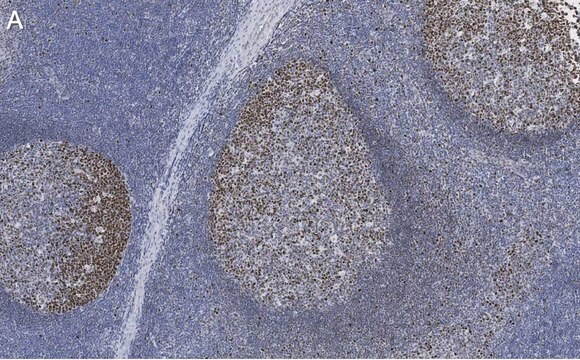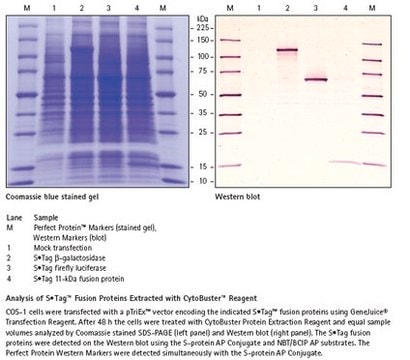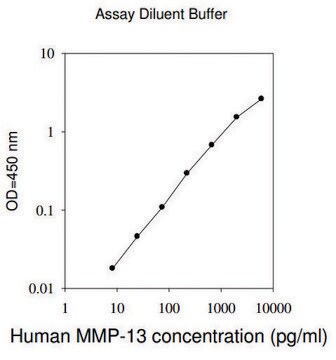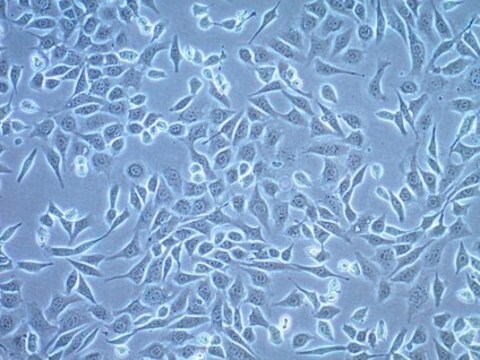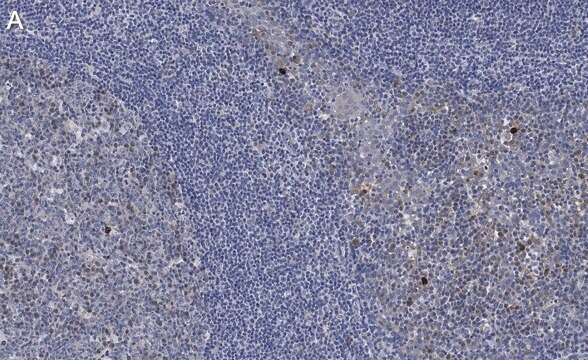SCCAR10148
Assay Ready MB49 Mouse Bladder Carcinoma Cell Line
Synonim(y):
MB-49, mysi rak pęcherza moczowego
Zaloguj sięWyświetlanie cen organizacyjnych i kontraktowych
About This Item
Kod UNSPSC:
41106514
NACRES:
NA.81
Polecane produkty
pochodzenie biologiczne
human
Poziom jakości
opakowanie
vial of 1 vial
producent / nazwa handlowa
Millipore
metody
cell culture | stem cell: suitable
Warunki transportu
liquid nitrogen
temp. przechowywania
−196°C
Opis ogólny
Komórki MB49 pochodzą z komórek nabłonkowych pęcherza myszy C57BL/Icrf-a', które zostały przekształcone w wyniku pojedynczego 24-godzinnego traktowania chemicznym czynnikiem rakotwórczym 7,12-dimetylobenz[a]antracenem (DMBA) w drugim dniu długotrwałej hodowli pierwotnej (1). Wykazano, że transformowane komórki przeszczepione do myszy syngenicznych generują raka (1). Chociaż są pochodzenia męskiego, analizy kariotypu wskazują na utratę chromosomu Y w 100% analizowanych komórek (2). Ta nieprawidłowość jest częstym wczesnym zjawiskiem w ludzkim raku pęcherza moczowego.
Ostatnie badania wskazują, że komórki MB49 odzwierciedlają kluczowe cechy różnic płciowych we wzroście guza pęcherza moczowego (3). Implantacja MB49 u myszy skutkowała znacznie większymi guzami u samców niż u samic. W obecności dihydrotestosteronu komórki MB49 wykazywały zwiększoną proliferację w sposób zależny od dawki. W przeciwieństwie do tego, komórki MB49 nie reagowały na hormon ciążowy, ludzką gonadotropinę kosmówkową (hCG) (3).
Komórki MB49 wykazują niską lub zerową ekspresję cząsteczek MHC klasy I i II (4). Jednak po ekspozycji na IFN-?, ekspresja MHC klasy I i II jest znacznie zwiększona (4).
Referencje:
1. Summerhayes IC, Franks LM (1979) Effects of donor age on neoplastic transformation of adult mouse bladder epithelium in vitro. J Natl Cancer Inst 62(4): 1017 - 1023.
2. Fabris VT, Lodilinsky C, Pampena MB, Belgorosky D, Lanari C, Eiján AM (2012) Cytogenetic characterization of the murine bladder cancer model MB49 and the derived invasive line MB49-I. Cancer Genet 205(4): 168 - 76.
3. White-Gilbertson S, Davis M, Voelkel-Johnson C, Kasman LM (2016) Sex differences in the MB49 syngeneic, murine model of bladder cancer. Bladder (San Franc) 3(1): PMID: 26998503.
4. Lattime EC, Gomelia LG, McCue PA (1992) Murine bladder carcinoma cells present antigen to BCG-specific CD4+ T-cells. Cancer Res 52(15): 4286 - 90.
Ostatnie badania wskazują, że komórki MB49 odzwierciedlają kluczowe cechy różnic płciowych we wzroście guza pęcherza moczowego (3). Implantacja MB49 u myszy skutkowała znacznie większymi guzami u samców niż u samic. W obecności dihydrotestosteronu komórki MB49 wykazywały zwiększoną proliferację w sposób zależny od dawki. W przeciwieństwie do tego, komórki MB49 nie reagowały na hormon ciążowy, ludzką gonadotropinę kosmówkową (hCG) (3).
Komórki MB49 wykazują niską lub zerową ekspresję cząsteczek MHC klasy I i II (4). Jednak po ekspozycji na IFN-?, ekspresja MHC klasy I i II jest znacznie zwiększona (4).
Referencje:
1. Summerhayes IC, Franks LM (1979) Effects of donor age on neoplastic transformation of adult mouse bladder epithelium in vitro. J Natl Cancer Inst 62(4): 1017 - 1023.
2. Fabris VT, Lodilinsky C, Pampena MB, Belgorosky D, Lanari C, Eiján AM (2012) Cytogenetic characterization of the murine bladder cancer model MB49 and the derived invasive line MB49-I. Cancer Genet 205(4): 168 - 76.
3. White-Gilbertson S, Davis M, Voelkel-Johnson C, Kasman LM (2016) Sex differences in the MB49 syngeneic, murine model of bladder cancer. Bladder (San Franc) 3(1): PMID: 26998503.
4. Lattime EC, Gomelia LG, McCue PA (1992) Murine bladder carcinoma cells present antigen to BCG-specific CD4+ T-cells. Cancer Res 52(15): 4286 - 90.
Cechy i korzyści
Implantacja MB49 u myszy skutkowała znacznie większymi guzami u samców niż u samic. W obecności dihydrotestosteronu komórki MB49 wykazywały zwiększoną proliferację w sposób zależny od dawki. W przeciwieństwie do tego, komórki MB49 nie reagowały na hormon ciążowy - ludzką gonadotropinę kosmówkową (hCG) [3]. Komórki MB49 wykazują niską lub zerową ekspresję cząsteczek MHC klasy I i II [4]. Jednakże, po ekspozycji na IFN-?, ekspresja MHC klasy I i II jest znacznie zwiększona
Opis wartości docelowych
Komórki MB49 wywodzą się z komórek nabłonkowych pęcherza myszy C57BL/Icrf-a, które zostały przekształcone przez pojedynczą 24-godzinną terapię chemicznym czynnikiem rakotwórczym 7,12-dimetylobenz[a]antracenem (DMBA) w drugim dniu długotrwałej hodowli pierwotnej [1]. Wykazano, że transformowane komórki przeszczepione do myszy syngenicznych generują raka [1]. Chociaż są pochodzenia męskiego, analizy kariotypu wskazują na utratę chromosomu Y w 100% analizowanych komórek [2]. Ta nieprawidłowość jest częstym wczesnym zjawiskiem w ludzkim raku pęcherza moczowego. Ostatnie badania wskazują, że komórki MB49 odzwierciedlają kluczowe cechy różnic płciowych we wzroście guza pęcherza moczowego.
Przechowywanie i stabilność
Komórki MB49 powinny być przechowywane w ciekłym azocie.
Inne uwagi
Ten produkt jest przeznaczony do sprzedaży jako materiał eksploatacyjny. Nie może on być rozmnażany, pasażowany ani ekspandowany i podlega warunkom "Umowy o wykorzystaniu badawczym komórek gotowych do testów", jak wyszczególniono w dokumentacji produktu. W celu uzyskania informacji dotyczących innych zastosowań prosimy o kontakt pod adresem licensing@milliporesigma.com.
Oświadczenie o zrzeczeniu się odpowiedzialności
O ile nie określono inaczej w naszym katalogu lub innej dokumentacji firmy dołączonej do produktu(-ów), nasze produkty są przeznaczone wyłącznie do użytku badawczego i nie mogą być wykorzystywane do żadnych innych celów, w tym między innymi do nieautoryzowanych zastosowań komercyjnych, zastosowań diagnostycznych in vitro, zastosowań terapeutycznych ex vivo lub in vivo lub jakiegokolwiek rodzaju konsumpcji lub zastosowania u ludzi lub zwierząt.
Ta strona może zawierać tekst przetłumaczony maszynowo.
Kod klasy składowania
12 - Non Combustible Liquids
Klasa zagrożenia wodnego (WGK)
WGK 2
Temperatura zapłonu (°F)
Not applicable
Temperatura zapłonu (°C)
Not applicable
Certyfikaty analizy (CoA)
Poszukaj Certyfikaty analizy (CoA), wpisując numer partii/serii produktów. Numery serii i partii można znaleźć na etykiecie produktu po słowach „seria” lub „partia”.
Masz już ten produkt?
Dokumenty związane z niedawno zakupionymi produktami zostały zamieszczone w Bibliotece dokumentów.
Nasz zespół naukowców ma doświadczenie we wszystkich obszarach badań, w tym w naukach przyrodniczych, materiałoznawstwie, syntezie chemicznej, chromatografii, analityce i wielu innych dziedzinach.
Skontaktuj się z zespołem ds. pomocy technicznej
